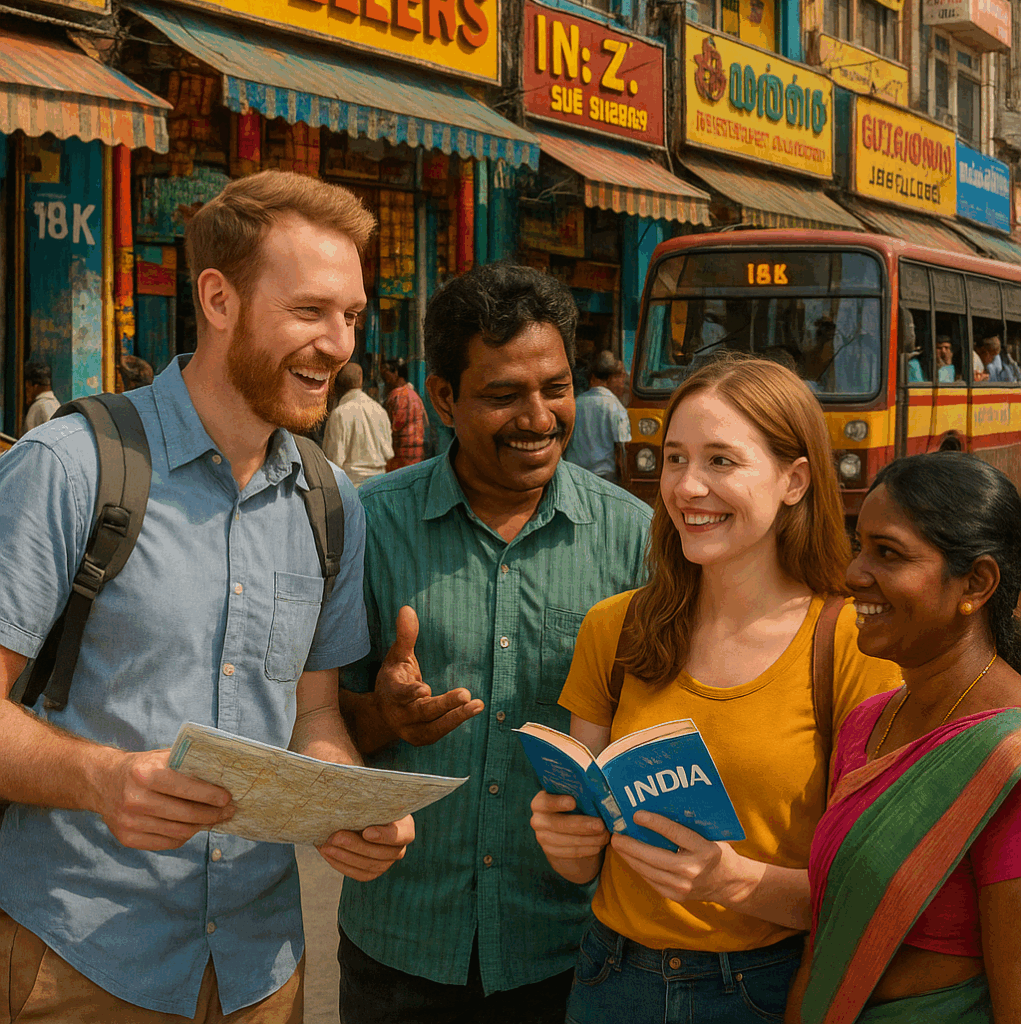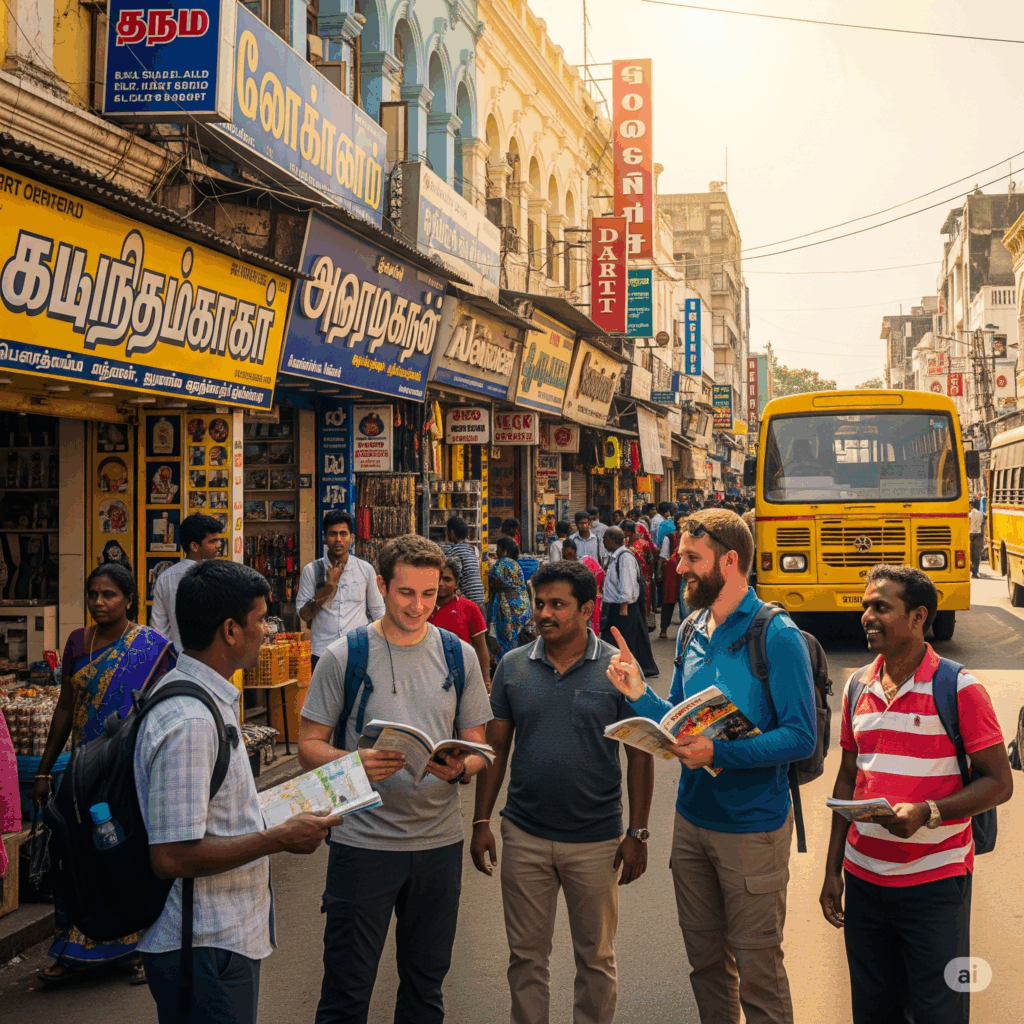
Why Learn Spoken Tamil for Travel?
Imagine arriving in Chennai or Madurai and confidently greeting locals with a warm “Vanakkam!”. Learning just a bit of Tamil can transform your trip into a rich adventure. Tamil isn’t just another language—it’s a 6,000-year-old time capsule of culture, literature, and spicy rasam recipes. By learning a few key phrases, you’ll impress shopkeepers, connect deeply with people, and get insider tips that tourists usually miss. As one guide notes, “Whether you’re reconnecting with roots, prepping for a trip to Tamil Nadu… this guide is your golden ticket”.
So, if you want to learn spoken Tamil for travel, you’re in the right place. This doesn’t mean hundreds of hours of grammar. In fact, we teach Tamil through English (called Tanglish) to jump straight into conversation. No need to wrestle with the Tamil script at first – just pick up phrases and pronunciation, and you’ll be ready to chat by Day 1. Even saying simple phrases like “Vanakkam” (Hello) or “Nandri” (Thank you) earns instant smiles and respect.
Why bother? Because Tamil speakers love when visitors make the effort. A few Tamil words can turn a stranger into a friend. Parvathy (7 years of experience teaching Tamil) and hundreds of our students have seen this magic. One student from the USA bragged, “I ordered food in Chennai without pointing at menus!” after practicing a bit. Another backpacker exclaimed, “I traveled solo to Madurai and made friends at a tea stall—no English needed!”. That could be you. Read on for practical tips, phrases, and real-world examples to help learn spoken Tamil for travel in a fun, fast way.
Essential Tamil Phrases for Travelers
Here are some must-know Tamil phrases for any traveler. Learn these and you’ll handle common travel moments with ease:
- Greetings & Politeness:
Vanakkam (வணக்கம்) – Hello / Welcome.
Nandri (நன்றி) – Thank you.
Eppadi irukeenga? (எப்படி இருக்கீங்க?) – How are you? (formal). You can reply “Nallaa irukken” – I’m fine.
Saaptacha? (சாப்பிடச்சா?) – “Did you eat?”. This quirky phrase is a common Tamil way to ask “How are you?”. - Making Purchases:
Idli evlo? (இட்லி எவ்வளவு?) – How much for the idli? (or replace idli with the item). Konjam (கொஞ்சம்) – a little; kurai (குறை) – reduce. E.g., “Konjam kurai kudunga” – “Please lower the price a bit.”
ATM enga iruku? – Where is an ATM?
Rupee/rapping: (ஒரு நாணயம்) – Rupē (rupee); learning 1 (oru), 2 (irendu), 5 (anju) helps with counting and bargaining. - Directions & Transport:
Inge / Anga (இங்கே/அங்கே) – Here/There.
Poganum (போகணும்) – Need to go. E.g., “Bus stand inga eppa poganum?” – “Which way to the bus stand?”
Train eppati? (றயில் எப்போடீ?) – When does the train go? - Food & Accommodation:
“One room, adu oru a/c irukkuma?” – “Is one room with AC available?” (or skip AC if basic).
“Filter kaapi oru one / two?” – “One or two filter coffees?” – No need to translate “filter kaapi”, it’s universal in Tamil.
“Idly saapitaacha?” – (pronounced similar to earlier). - Survival Phrases:
“Evlo neram?” (எவ்வளவு நேரம்?) – How long? (e.g., waiting).
“Inge bathroom iruka?” – Is there a bathroom here?
“Help!” – Even shouting “Saamiyaa!” (சாமியா!) can alert friendly locals (it means “Oh God!” but is used to get attention).



All of these will come in handy. Remember, perfect pronunciation isn’t required – Tamils are famously forgiving and will appreciate any effort. Start with “Vanakkam!”, smile, and you’re on the way to a Tamil conversation. Even a few phrases like “Yenakku pudikkala” (“I don’t like it”) or “Saaptacha?” are learned immediately in beginner courses. Those fun sentences are real Tamil – so use them boldly!
How to Learn Spoken Tamil Quickly: Top Tips
Ready to learn spoken Tamil for travel even faster? Here are some friendly, effective strategies:
- Use Tanglish (Roman script) – Don’t worry about learning the Tamil alphabet at first. We write Tamil words in English letters (e.g., “Tamil” becomes “Thamizh”). This Tanglish method means you can start speaking immediately. For example, “Vanakkam” is how we write வணக்கம் in English letters. This shortcut saves time and gets you talking from Day 1.
- Learn a few phrases at a time – Set small goals like learning 5–10 phrases per week. As [53] advises, focus on survival phrases first. Practice them until comfortable. Then add more. Watching one Tamil movie a month with subtitles or chatting weekly with a Tamil speaker helps keep it fun.
- Label your world – Stick Tamil word labels on everyday objects at home. Write “arai” (அறை) on the bedroom door, “samayal” (சமையல்) on the kitchen door. Every time you walk through, say the word. Your dog might think you’re weird, but you’ll absorb vocab without even realizing it!
- Immerse with media – Listen to Tamil music or watch simple Tamil shows. Children’s cartoons (like Chhota Bheem dubbed in Tamil) or songs by Harris Jayaraj can train your ear. Try Tamil YouTube travel vlogs or our Tamil playlist. It’s like a mini-immersion: you’ll pick up everyday expressions and accent naturally.
- Practice out loud with people – Find a language partner online or in person. Even chatting with fellow travelers who know a little Tamil can help. Role-play ordering food or asking for directions. (We often advise students to role-play a Chennai street market, bargaining for souvenirs – it’s fun practice.) If possible, join a group class (we have live group sessions that are low-pressure). The key is speaking – even if it’s imperfect. One tip from our community: record yourself saying a phrase on Day 1 and compare after a week – you’ll be amazed at your progress.
- Use tech tools – Free apps and online lessons are your friends. Use Google Translate or Tamil-learning apps for quick practice on the go. Some apps even have Tamil pronunciation exercises (our AI Pronunciation Coach focuses on tricky sounds like “ழ” for you). Set your phone or GPS to Tamil occasionally to build familiarity.
- Cultural context – When you learn a phrase, also learn when to use it. For example, “Enga bus station?” means “Where is the bus station?” and is always polite. Learning about local customs (like not pointing your feet at people or elders) helps too. Over time, you’ll naturally pick the tone and gestures that go with your Tamil.
Each of these methods focuses on getting you speaking quickly. Remember [53]’s advice: “Start small… focus on spoken Tamil first”. The script can come later – the priority is making yourself understood on the road.



Using Tamil in Real Travel Scenarios
Putting Tamil to use is the best way to learn. Let’s see some common travel situations and the Tamil phrases that work there:
- At a hotel or homestay: Greet the staff with “Vanakkam, unga room irukka?” (Hello, do you have a room?). If your luggage is heavy, say “Udane vaa seiyya?” (Could you please come quickly to help?). When paying, ask “Idhoda bill eppa varum?” (When will the bill come?).
- Ordering food: At a restaurant or street stall, you might say “Idly oru dousai tharaamaa?” (One idly, one dosa please?). Add “Ramya’a thara” (give it quickly) with a smile. If it’s spicy, you can smile and say “Kurayavai pakka?” (A little spicy). When leaving, don’t forget “Nandri!”.
- Asking directions: If you need to catch a bus or see a landmark: “’Korattur-ikku enge bus varum?’ (Where is the bus to Korattur?). For “Where is the restroom?” say “Restroom enga iruku?”. Tamils are very friendly with directions – you’ll likely get a 5-minute Tamil lesson instead of a “yes/no” answer!
- Shopping and markets: Markets can be fun and chaotic! Start with “Idhu evlo?” (How much is this?). Vendors often ask “Konjam kammi kodunga” (I’m not sure, you negotiate!). If you want to pay a big note, say “Ippo konjam return panunga” (Please give me change). Phrases like “Nalla deal?” (Good deal?) or “Oru second” (one second) while holding items will serve you well.
- Transportation: Hailing a rickshaw or cab? Simply say “Chennai beach-ku poi use pannunga” (Take me to Chennai Beach). If you need help, ask “Help pannunga”. On a train, ask the ticket clerk “Irundu bullet train?” (Is this a reserved ticket?).
Each situation is an opportunity to learn spoken Tamil for travel. The more you use it, the quicker it sticks. Don’t be shy – people will enjoy teaching you. One traveler, Linda from Germany, said she “made friends at a tea stall – no English needed!” after learning a bit. You could be next!
Cultural Tips for Tamil Nadu Travelers
Tamil Nadu culture is warm and hospitable, and knowing some local etiquette goes a long way:
- Respectful Speech: Use “Nīṅga” (நீங்கள்) when speaking to elders or strangers (formal you) and “nī” (நீ) only with close friends. A gentle head nod or slight bow with “Vanakkam” is a friendly greeting.
- Body Language: Tamils often use the “head bobble” – a quick tilt of the head – to mean “yes” or acknowledgement. Don’t be confused; it’s positive! Also, keep your feet on the floor; pointing feet at people or deities is impolite.
- Time and Pace: Things move a bit more slowly in India; “Tamil Time” means punctuality isn’t strict. A patient smile goes a long way.
- Temples & Traditions: Remove shoes before entering temples or some shops (look for others doing it). If you hear “Aiyō!” (அய்யோ), it’s usually an expression of sympathy or surprise – not anger. Similarly “Adada!” (அடடா) is like “Oh wow!”. These colorful exclamations add local flavor. Learning them can help you understand guides (“Temples are 1,000 years old – Adada!, can you believe it?”).
- Food Culture: If offered food or drink (chai, banana, etc.), it’s polite to accept at least a small amount. Saying “micchaadhan!” shows deep gratitude (often to elders). But a simple “nandri” works any time.
- Festival Season: If you travel during festivals like Pongal or Diwali, you might hear “Ippadiye irundha…“ jokes or riddles. People love to share sweets. Joining in is a great way to practice phrases like “Ithu endra tamil?” (What is this called in Tamil?).



In short, stay curious and respectful. Even when you make mistakes, Tamils will usually laugh lovingly and correct you kindly. The key is to show interest. They’ll often respond with even more Tamil, eager to test your skills. This friendly give-and-take is exactly why you learn spoken Tamil for travel: to break down barriers and experience the real India, not just the tourist facade.
Tech Tools & Resources to Learn Spoken Tamil
Let’s not forget modern help. Here are some high-tech allies:
- Tamil Learning Apps: Apps like Ilango Tamil Tutor, Learn Tamil Quickly, or even Duolingo’s beta Tamil course offer bite-sized lessons. Use them to practice vocabulary or grammar at your own pace.
- Phrasebook & Flashcards: Carry a small Tamil phrasebook (we have a “Pocket Phrasebook” with audio if you join our course) or use flashcard apps (Anki has Tamil decks). Review daily – even 5 minutes in your spare time adds up.
- Online Videos & Podcasts: YouTube channels (like Tamil travel vlogs or beginner Tamil lessons) and Tamil podcasts (for kids or travel stories) are great. Listen on the go. When you travel, you’ll notice words in song lyrics or bus announcements and say “Oh, I know that one!”
- Language Exchanges: Facebook groups or Meetup often have India travel or Tamil culture groups. Connect with a Tamil speaker who wants to practice English; you can swap languages. Nothing beats real conversation.
- WhatsApp/SMS Practice: Try chatting with a friend or fellow student in Tamil (even if it’s just using Roman letters). You could record a voice note saying a simple Tamil sentence. Reviewing your own voice messages is like your personal teacher pointing out progress.
Remember, consistency is key. Even a little Tamil every day – through apps, songs, or conversation – will accelerate your learning. We encourage our learners to also use our daily Tamil WhatsApp channel for quick tips and memes to keep Tamil fresh in your mind.
Special Offers: Free Demo & Free Classes for ” Learn Spoken Tamil”
One more reason to start now: special promotions! We want you to feel welcome and confident. That’s why every traveler can book a free demo session with one of our expert Tamil tutors – no strings attached. You’ll get a taste of how fun Tamil learning can be.
PLUS, the first three classes are completely free for the first 3 students who sign up after reading this. That’s right: you get 3 lessons on us! It’s our way of thanking you for choosing to learn spoken Tamil for travel. Whether you’re from the USA, Canada, or Europe, this offer gives you a head start.
Don’t wait on this – spots fill up fast. After all, mastering just a few phrases can change a holiday into an incredible journey. Our sign-up page is easy, and our demo is no-pressure. Think of it as a friendly meeting where we chat about your travel plans and give you a fun mini-lesson. By the end, you’ll already know a couple of extra Tamil words.
Conclusion & Call to Action
You’ve read the tips and seen how accessible Tamil can be. Now it’s time to take that step. Learning Tamil will make your travels richer, more joyful, and unforgettable. We’ve shown you how to learn spoken Tamil for travel without intimidation – by focusing on phrases, culture, and practice.
So, are you ready to start? Book your free demo session now and secure your free classes. Imagine walking through a Tamil market saying “Vanakkam!” or chatting with your homestay host – it’s within reach. The journey of a thousand miles begins with “Vanakkam,” and we’re here to guide you every step.
Happy travels and happy learning! We can’t wait to meet you in class. Let’s get you speaking Tamil – your adventure awaits!
To register to Learn Spoken Tamil :
- Call us: https://wa.me/918870455244
- Email: [email protected]
Visit www.learntamilonline.com to get started.


